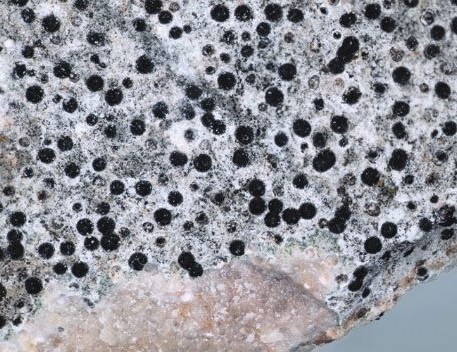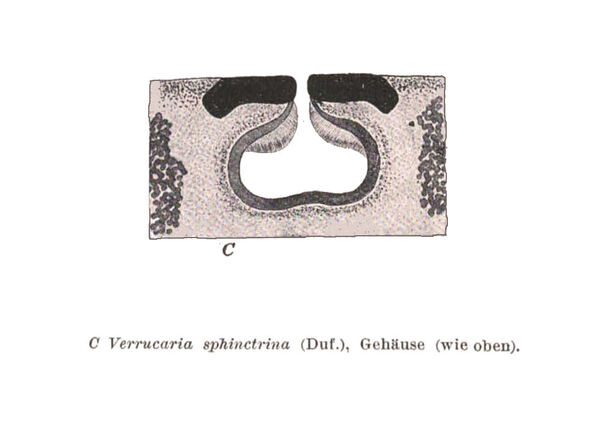Bagliettoa limborioides A. Massal.
Mem. Lichenogr.: 147, 1853.
Synonyms: Bagliettoa sphinctrina auct. non (Ach.) Körb.; Protobagliettoa grummannii (Servít) Servít; Verrucaria bosniaca Servít; Verrucaria ceracea J. Steiner; Verrucaria limborioides (A. Massal.) Clauzade & Cl. Roux; Verrucaria sphinctrina auct. p.p. non Ach.; Verrucaria subconcentrica (J. Steiner) Servít var. euthallina Servít f. genovensis Servít
Distribution: N - VG, Ven, TAA, Lig (Lazzarin 2000b, Halda 2003). C - Umb (Genovesi & Ravera 2001, Ravera & al. 2006), Sar (TSB 13839). S - Pugl (Nimis & Tretiach 1999), Si (Nimis & al. 1994, Caniglia & Grillo 2005, 2006, Grillo & al. 2007b).
Description: Thallus crustose, fully endosubstratic, usually covering large surfaces, white to pale grey. Cortex (lithocortex) densely prosoplectenchymatous, of conglutinated hyphae intermingled with microcrystals; algal layer discontinuous, the algal cells in clusters; medulla prosoplectenchymatous, with oil cells (macrosphaeroids) in lower part. Perithecia black, completely immersed in thallus and leaving deep pits in the rocks when they fall off. Involucrellum prominent, with radial cracks around the ostiole, usually broader than the body of the perithecium (0.3-0.4 mm wide), with a distinctly raised, convex center; exciple 0.3-0.35 mm wide, the wall colourless to brown; hymenial gel hemiamyloid, I+ red (I+ blue at very low concentrations of I), K/I+ blue; hamathecium of periphyses in the ostiolar canal, and short periphysoids in the half upper part of the perithecial cavity; paraphyses dissolving early. Asci 8-spored, two-layered, fissitunicate, with a thin tholus reacting I-, Verrucaria-type. Ascospores 1-celled (very rarely a few 1-septate), hyaline, ellipsoid, often poorly developed, 17-35 x 10-13 µm. Photobiont chlorococcoid. Spot tests: K-, C-, KC-, P-, UV-. Chemistry: without lichen substances. Note: a mild-temperate to Mediterranean lichen found on steeply inclined faces of compact calcareous rocks below the subalpine belt; probably more widespread but overlooked, or confused with similar species.
Growth form: Crustose endolithic
Substrata: rocks
Photobiont: green algae other than Trentepohlia
Reproductive strategy: mainly sexual
Commonnes-rarity: (info)
Alpine belt: absent
Subalpine belt: absent
Oromediterranean belt: absent
Montane belt: very rare
Submediterranean belt: rare
Padanian area: absent
Humid submediterranean belt: rare
Humid mediterranean belt: rare
Dry mediterranean belt: very rare

Predictive model
Herbarium samples
Growth form: Crustose endolithic
Substrata: rocks
Photobiont: green algae other than Trentepohlia
Reproductive strategy: mainly sexual
Commonnes-rarity: (info)
Alpine belt: absent
Subalpine belt: absent
Oromediterranean belt: absent
Montane belt: very rare
Submediterranean belt: rare
Padanian area: absent
Humid submediterranean belt: rare
Humid mediterranean belt: rare
Dry mediterranean belt: very rare

Predictive model
| Herbarium samples |
 INDEX FUNGORUM
INDEX FUNGORUM
 GBIF
GBIF
 DOLICHENS
DOLICHENS



